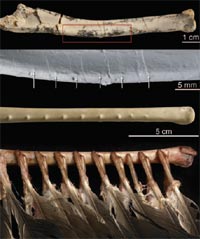This article is reposted from the old Wordpress incarnation of Not Exactly Rocket Science.
In Jurassic Park, the role of Velociraptor was played by computer-generated reptilian actors, that bore little resemblance to the real deal. The actual dinosaur was smaller, slower and used its infamous claw to stab (or possibly climb) rather than disembowel. And in 2007, scientists found good evidence that it was covered in feathers.
Since Jurassic Park aired, dinosaurs like Velociraptor have received something of a makeover. It began in the late 1990s when Chinese palaeontologists found a stunning series of dinosaur fossils with distinct traces of feathers around their bodies. Some were just covered in a downy fluff, while others like Microraptor had fully-formed wings and were probably capable of true flight.
 These species were primitive members of the dromaeosaurids, a group of small, agile predators that Velociraptor also belongs to. With feathered ancestors and evolutionary cousins, it was always extremely likely that Velociraptor also had a feathered coat but until now, that was always an educated guess.
These species were primitive members of the dromaeosaurids, a group of small, agile predators that Velociraptor also belongs to. With feathered ancestors and evolutionary cousins, it was always extremely likely that Velociraptor also had a feathered coat but until now, that was always an educated guess.
The breakthrough came from Alan Turner and Mark Norell from the American Museum of Natural History and Peter Makovicky of the Field Museum of Chicago. They were studying the forearm of a Velociraptor unearthed in 1998, when they noticed six evenly spaced knobs of bone on the back edge.
The team recognised these as quill knobs, small lumps of bone that act as attachment points for feathers. These knobs are direct evidence that Velociraptor carried a row of feathers on its forearm, probably about 14 by Turner's count. You can see them in the top two images above. The bottom two show the equivalent structures in a modern vulture, and how feathers are attached to them.
The quill knobs also suggest that Velociraptor's feathers had a distinctly modern style. They probably looked much like those of today's birds, rather than the hair-like proto-feathers of its ancestors.
Several well preserved Velociraptor skeletons have already been found but palaeontologists have never found the outlines of feathers that typifies the fossils of species like Archaeopteryx and Microraptor. Turner and co aren't surprised - these outlines have only ever been found in the smallest of dinosaurs.
The most beautiful feathered fossils hail from special sites called lagerstätten, a kind of universal graveyard where an amazing diversity of prehistoric species is preserved. At these places, the specific mixture of sediment and low oxygen levels delays the process of decay long enough for soft body parts, like feathers, to become preserved. But this only works for small dinosaurs, smaller still than Velociraptor.
 Feathers allow birds to fly and to keep themselves warm. But Velociraptor's forearm plumage probably fulfilled neither function. For its weight, its forearms were too small to provide powered flight, and feathers there wouldn't have helped the animal to retain much heat.
Feathers allow birds to fly and to keep themselves warm. But Velociraptor's forearm plumage probably fulfilled neither function. For its weight, its forearms were too small to provide powered flight, and feathers there wouldn't have helped the animal to retain much heat.
Instead, Turner suggest that Velociraptor could have used its feathers to display to mates or rivals, to shield their nests from the cold, or to manoeuvre while running .
Its smaller ancestors probably did use their feathers for flight (or at the very least, efficient gliding), and Velociraptor kept them but co-opted them for other purposes. To their ancestors, Velociraptor and its kin would have been like prehistoric ostriches, having abandoned flying for a running life.
Feathers can join the list of bird features shared by dromaeosaurids, including wishbones, nest brooding and hollow bones. Discoveries like these further blur the distinction between this dinosaur lineage and their modern descendants.
Birds are now all classified as living dinosaurs, but some palaeontologists argue that there is a case for classifying dromaeosaurs as birds. As Norell himself says, "If animals like Velociraptor were alive today our first impression would be that they were just very unusual looking birds."
Reference: Turner, Makovicky & Norell. 2007. Feather quill knobs in the dinosaur Velociraptor. Science doi:10.1126/science.1145076.
- Log in to post comments




Aw, man! I thought that there was a new paper when I saw the title on the front page. Still pretty damn cool, though!
So has anyone tried to figure out if dinosaurs ... uh ... chirped? That would be one big ole deep chirp, I would think.
Seriously did they vocalize? Thanks.